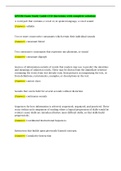Exam (elaborations)
KPEERI Exam Study Guide (350 Questions with complete solution)
- Course
- Institution
KPEERI Exam Study Guide (350 Questions with complete solution) A word part that contains a vowel or, in spoken language, a vowel sound {{Answer:- syllable Two or more consecutive consonants which retain their individual sounds {{Answer:- consonant blend Two consecutive consonants that re...
[Show more]



